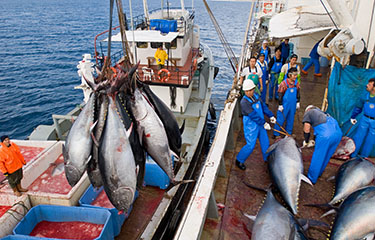ISSF report finds global tuna stock abundance getting worse

The recently released International Seafood Sustainability Foundation’s (ISSF) “Status of the Stocks” report found the world’s commercial tuna catch is increasingly being sourced from stocks that are not at healthy levels of abundance.
This twice-yearly report by the ISSF – a global coalition including seafood industry members and scientific and environmental organizations that promote science-based initiatives for long-term ocean health – provides the results for the most-recent scientific assessments of 23 separate stocks of major commercial tuna species. The stocks include six albacore, four bigeye, four bluefin, five skipjack, and four yellowfin tuna species.
The report found a decrease in the overall percentage of catch taken from species with healthy levels of abundance; the percentage decreased from 87.7 percent in the September 2021 report to 80.5 percent in the March 2022 report. Of the remaining 19.5 percent, 9.2 percent of the catch came from overfished stocks and 10.3 percent came from stocks at an intermediate level of abundance. The report attributes this reduction to a change in the Eastern Pacific skipjack stock – which represents around 6 percent of the global tuna catch – which has been downgraded from a green to yellow rating.
The report assigns color ratings (green, yellow, or orange) to stocks to assess their level of health. The color orange indicates sustainability concerns with no adequate corrective measures in place, yellow indicates sustainability concerns but adequate corrective measures in place, and green means there are no sustainability concerns.
This demotion of the Eastern Pacific skipjack stock is due to several factors, with the largest being an uncertainty in stock status, as the IATTC has not conducted an assessment of skipjack since 2012, ISSF reported. It also found historical low average fish size of and higher mortality due to fish-aggregating devices (FADs) used in the fishery.
To receive a color rating, the stock is assessed on three factors: abundance, management (fishing mortality), and environmental impact (bycatch). Since the last report, the Atlantic Ocean bigeye stock improved its fishing mortality from orange to green and its spawning biomass from orange to yellow. However, Mediterranean albacore was demoted in both spawning biomass from yellow to orange and fishing mortality from green to orange.
According to the report, three tuna stocks are considered overfished: Indian Ocean yellowfin, Pacific bluefin tuna, and Mediterranean albacore. Two stocks are subject to overfishing: albacore and bigeye found in the Indian Ocean.
Of the 23 stocks surveyed, 61 percent are at healthy levels of abundance or spawning biomass, 26 percent are at an intermediate level, 13 percent are overfished. In addition, 69.6 percent of the 23 stocks are experiencing a well-managed fishing mortality rate, and 21.7 percent are experiencing overfishing.
The total catch across all commercial tuna stocks was 4.9 million metric tons (MT) in 2020, 10 percent lower than the total catch in 2019. The five largest catches by volume were unchanged from the last report: Western Pacific Ocean skipjack, Western Pacific Ocean yellowfin, Indian Ocean skipjack, Indian Ocean yellowfin, and Eastern Pacific Ocean skipjack. Overall, 57 percent of the total catch in 2020 was skipjack tuna, followed by 30 percent from yellowfin, 8 percent for bigeye, and 4 percent of albacore. Bluefin tuna accounted for 1 percent of the total catch.
There have been minimal changes in fishing gear type since the last report. ISSF said 66 percent of the world's tuna catch is made by purse-seining – 36 percent associated or FAD sets, 27 percent unassociated or free-school sets, and 3 percent dolphin sets. An additional 10 percent of the catch is completed by longliners, 7 percent by pole-and-line fishers, 4 percent by gillnets, and the remaining 13 percent is performed with miscellaneous gear.
The report also touched on the possible impact of the pandemic on accurate data coverage. Since March 2020, there have been four updated reports. During this time, regional fishery management organizations have issued exemptions to certain monitoring requirements, such as observer coverage, potentially reducing the accuracy of the reporting completed during the COVID-19 pandemic.
Photo courtesy of zaferkizilkaya/Shutterstock






Share